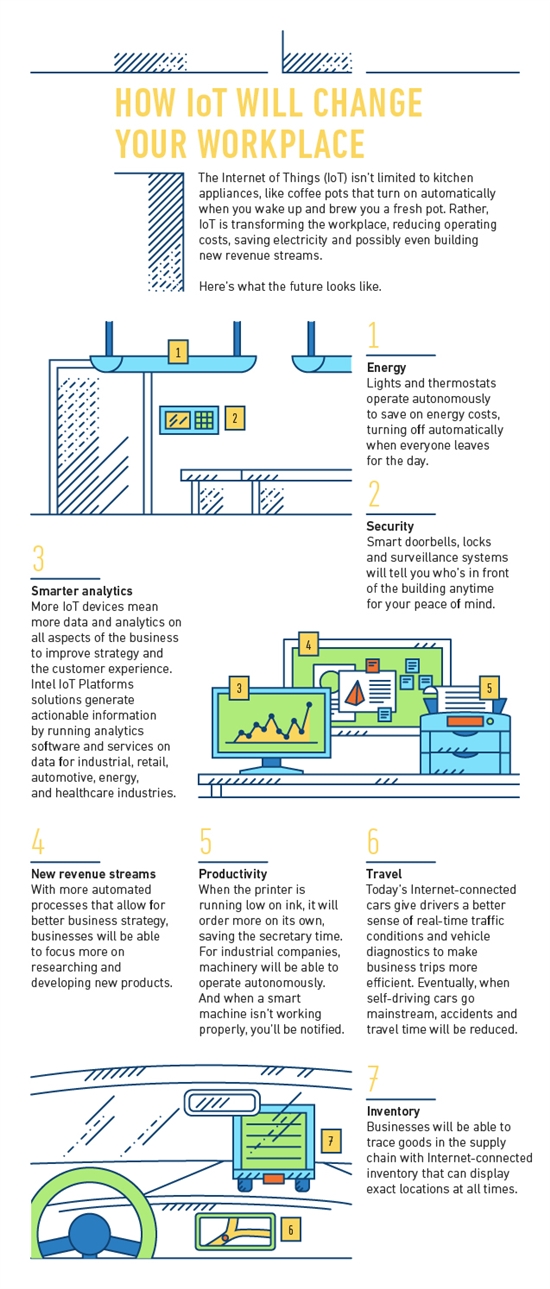By Megan Anderle, Editor and Contributing Writer
Once heralded as a symbol of technological advancement, the Internet of Things (IoT) has been called the most overhyped technology in development today due to a lack of standardization of data, wireless protocols and technologies.
And while it’s arguable that wearable and connected home devices have reached a peak of inflated expectations, IoT-connected devices used in business settings are just beginning to catch on in a change akin to the Industrial Revolution.
New buildings have been equipped with connected energy management solutions, such as heating and lighting systems that operate autonomously according to how many people are in a room at a given time. When smart grids that manage energy distribution are combined with smart meters, the payoff is significant.
Machines in factories now have sensors that notify workers as soon as there’s a problem. Building surveillance systems have been upgraded with connected locks and camera systems that inform managers instantly when someone is around or attempting to gain entry. And finally, inventory can now be tracked in real time, all thanks to IoT.
“For the first time, we can see what’s happening in real time in the physical world, and data that used to be siloed is now flowing into one place,” said Jack Reader, business development manager at ThingWorx. “Businesses can now tell when a machine is going to break down and take it out of production, replacing it with a backup machine, to keep productivity going.”
It prevents businesses from stopping the operations when something breaks down and losing a ton of money, he added.
“That’s the disruptive nature of the Internet of Things and the value proposition,” Reader said.
Intel’s IoT Platform connects all kinds of unconnected devices with its end-to-end solution that allows data from billions of devices, sensors and databases to be securely gathered, exchanged, stored and analyzed across multiple industries. Data will be unlocked faster to extract meaningful information and value for consumers and businesses.
Likewise, Dell’s Internet of Things (IoT) Lab helps customers build, modify and architect new IoT solutions.
The current state of IoT in business
As of now, there aren’t any regulatory impediments to IoT being deployed in businesses, and the payback is immediate, especially in the realm of energy management.
The IoT enterprise movement brings a few challenges, however. Retrofitting buildings with some connected technologies can be costly. Upgrading elevators to ThyssenKrupp’s connected elevators in buildings to predict imminent breakdowns, for instance, isn’t cheap.
Another challenge is aggregating all that data to make meaningful use out of it. Take city management, for example: the city managers who have data on pedestrians, air quality and traffic flow are in a much better position to make decisions than if they just had one of those sources. Analytics platforms are in the nascent stages of gathering and analyzing big data on operations, energy consumption and security for businesses, and it will be years before it’s done in a truly robust way.
Despite these obstacles, David G. Simmons, the chief technology evangelist at PsiKick, a company that manufactures ultralow-power sensors, compares IoT to the advent of the Internet in the ’90s.
“It will fundamentally change a lot of how we do things, at the same scale as the World Wide Web transformed the workplace in the ’90s,” he said. “And office workers won’t notice these things, but for the person who owns the building or pays the bills, it will make dramatically change things and make businesses more competitive.”
More automatic operations will allow businesses to innovate with new products, ultimately creating new revenue streams.
The future, protecting security
In 2015, 4.9 billion connected things will be in use, up 30 percent from 2014, and that number will reach 25 billion by 2020, according to Gartner. As a result, by the end of 2017, more than 20 percent of organizations will have digital security services devoted to protecting business initiatives using devices and services in IoT.
They’ll definitely need it, according to Don DeLoach, president and CEO at Infobright, which offers an IoT data analytics platform. Last year, a hacker took control of the thermostats, lights, TVs and window blinds in all 250-plus rooms of a hotel in Shenzhen, China, after discovering a vulnerability in the hotel’s “butler” mobile application that allows guests to control these settings with their smartphones and tablets. Who’s to say this won’t happen to a business? Or that someone won’t attack an entire smart grid?
“A lot of people are concerned about this happening,” DeLoach said. “There’s no doubt, the more access points you create, the more vulnerable you are.”
Right now, businesses are just beginning to confront how and where data travels. Security is a new frontier for IT departments that will have worries beyond employees bringing their own devices to work, especially with data being aggregated across multiple sources to inform decision making.
“As we sit on the cusp of implementing IoT, we need to be thinking these things through as we race to get these solutions out the door,” DeLoach said.
Check out the infographic below to see how IoT is changing the workplace.
